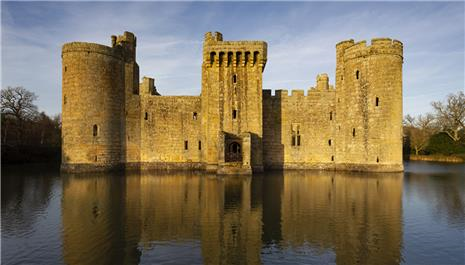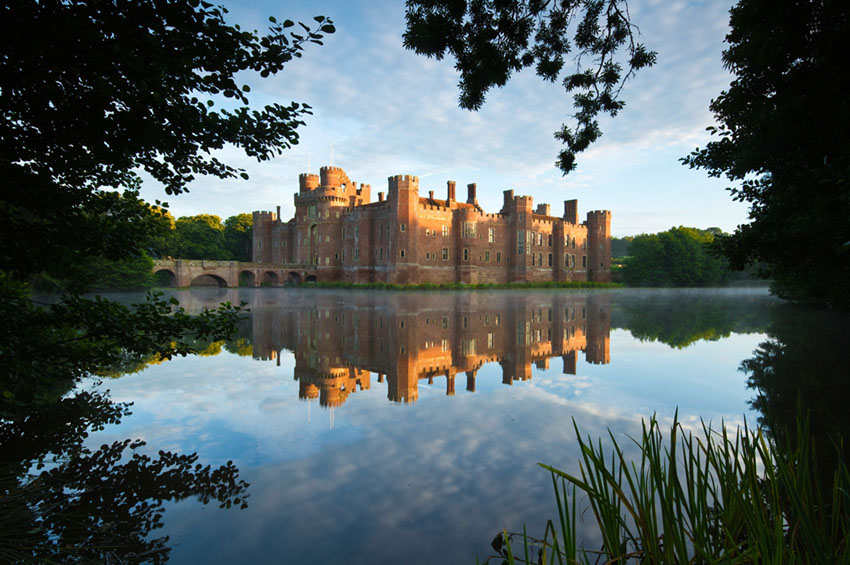The UK is renowned for its historic castles and royal residences – the most iconic naturally being Buckingham Palace. This summer, if you’re interested in viewing some of these landmarks across 1066 Country, here are some of the most influential residences that will conjure up images of monarchs and noblemen.

Bodiam Castle
Way back in the late 1300s, Sir Edward Dallingridge returned from France and used his wealth to build the beautiful Bodiam Castle, situated in East Sussex in the Rother Valley. Dallingridge was promoted by King Richard II to the position of warden of London, and the castle became known for its magnificent parties and events attended by British aristocracy and high society. Today, the romantic ruins of this gorgeous castle give visitors a peek into life in the time of Chaucer, and allow us to imagine living in medieval times.
Visitors can amble through the grounds and walk across the moat bridge to the gutted castle, before sitting down to a cup of tea and a light lunch at the tearoom onsite. This destination is popular during the summer months, especially over weekends, so booking ahead online is recommended.
Pevensey Castle
From even further back in history is Pevensey Castle, which used to be a Roman Saxon shore fort and was built in 290 AD. Though it’s not entirely clear why it was built originally, historians believe it served as a base for an ancient fleet called the Classis Anderidaensis, which defended the British coast against Saxon pirates. Others have suggested it was constructed to (unsuccessfully) hold back the imposition of Rome. After the Roman occupation it fell into ruin but was reinhabited in 1066 by the Normans, and was much later used as a World War Two fortress.
What remains today are the massive outer walls, and segments of the keep, towers and chapel. The castle is a treasure trove relating colourful episodes from British history, with a complete dungeon as well as a museum with fascinating artefacts including ancient weapons, household items and jewellery from the noble families inhabiting the castle over the centuries. Visitors can also see catapults and canons from the Elizabethan era.
Hastings Castle
The enchanting ruins of Hastings Castle are what remains of a formidable fortress built after William of Normandy was crowned King. William the Conquerer ordered a prefabricated wooden castle, to be built on top of a mound surrounded by a courtyard, in Hastings in 1066. After the conquest, there were many of these wooden castles erected all over the country. After the Battle of Hastings was won, the castle was reformed in stone. The was fully dismantled in 1216 by King John, fearing French invasion, but it was restored again in 1225 under Edward II.
Since then, the site has seen countless destructions, invasions and dissolutions. By 1591 the castle was owned by the Pelham family, but in 1951 it was sold to the Hastings Corporation for just £3,000.
Interested visitors can enjoy a condensed history of the site with their 20 minute audio tour, covering exciting highlights and fascinating details about how much the castle has changed over the centuries. From April to November, there are supersaver tickets available including Hastings castle and other attractions, making it an ideal choice for the family.

Herstmonceux Castle Estate
Dating from 1441, and built under order by Sir Roger Fiennes, this beautiful fairytale castle is the country’s oldest surviving brick building and used to be the largest private residence in England in the 15th century. Hersmontceux Castle boasts a moat, turrets, and towers on a 300 acre estate with formal gardens and a surrounding woodland.
There are occasionally group talks and tours in the ballroom, and the site hosts annual medieval events. In the meantime, families can enjoy the children’s play area, Georgian-style folly, gardens and rope maze – and the area is dog friendly, too.
History buffs and enthusiasts are spoiled for choice when it comes to exploring the historical residences with ties to the British monarchy. People of all ages can spend a day enjoying these monuments and the preserved treasures they hold from a bygone era. By exploring the many different royal residences from years past, one also learns a little about the rich and varied history of the country itself, and a fresh perspective on the past.
Text by Charlotte Murphy.
Sources:
Bodiam Castle, nationaltrust.org.uk/bodiam-castle
National Holidays, A Glimpse into Royal Life: The Family's Favourite Castles,
nationalholidays.com/blog/post/12-a-glimpse-into-royal-life
Hasting Castle, great-castles.com/hastings.html
Pevensey Castle, military.wikia.org/wiki/Pevensey_Castle
Herstmonceux Castle, herstmonceux-castle.com/










Comments
Comments are disabled for this post.